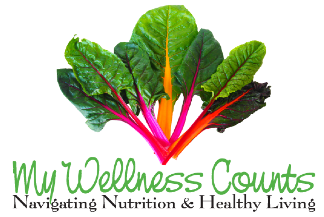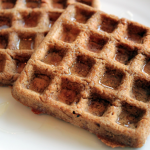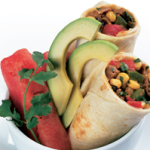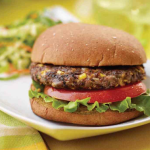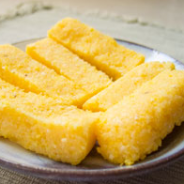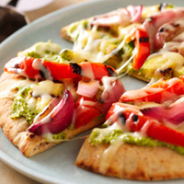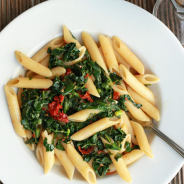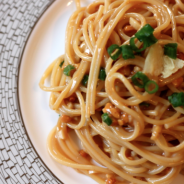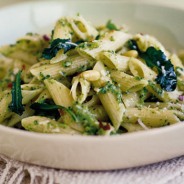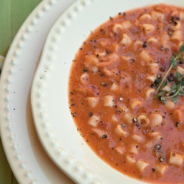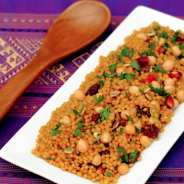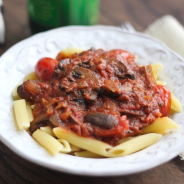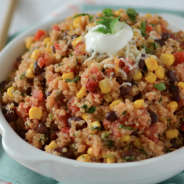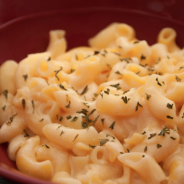Healthy Recipes
PCRM Food For Life Recipes
Certified Food For Life Cooking Instructor, Sari Dennis is also a Board Certified Health and Wellness Counselor, and Founder of My Wellness Counts, LLC. Sari works with professionalism and compassion, guiding her clients to prioritize their health by connecting sound nutrition with healthy lifestyle choices. Sari advocates the value of nutritional excellence as a path to vibrant health and happiness.
“Healthy surroundings create healthy thoughts, and healthy thoughts inspire healthy choices.”
Sari works in group-settings and one-on-one with individual clients, over the course of a 6-month period. Sari received her training at the Physicians Committee For Responsible Medicine and at the Institute for Integrative Nutrition in NYC. Sari is certified by Purchase College of the State University of New York (SUNY), and accredited through the American Association of Drugless Practitioners (AADP).
Below you will find easy ways to REPLACE your allergy-sensitive ingredients for healthy, plant-based options . . . so keep reading!
All recipes are 100% plant-based, and here are some of the many health related reasons why:
20 Quotes from the Experts
1. “Genetics loads the gun, lifestyle pulls the trigger.” – Caldwell Esselstyn, Jr., MD
2. “They say that vegetable food is not sufficiently nutritious. But chemistry proves contrary. So does physiology. So does experience…And again: the largest and strongest animals in the world are those which eat no flesh-food of any kind – the elephant and rhinoceros.” Russell Trall, MD
3. “It is the position of the American Dietetic Association that appropriately planned vegetarian diets, including total vegetarian or vegan diets are healthful, nutritionally adequate, and may provide health benefits in prevention and treatment of certain diseases.” ADA Position on Vegetarian Diets 2009
4. “Your choice of diet can influence your long term health prospects more than any other action you might take.” – Former Surgeon General C. Everett Coop
5. “You cannot buy health; you must earn it through healthy living.” – Joel Furhman, MD
6. “We have science to suggest that if you can make three changes – give up meat, all dairy, and refined foods including free oils – you can avoid dying form cancer and heart disease.” Mehmet Oz, MD
7. “People feel poorly because they are nourished by foods you wouldn’t feed to your dog or cat. The rich western diet is full of fat, sugar, cholesterol, salt, animal protein — all the wrong foods for people. Look around the world and see where people are thin and healthy — they live on a starch based diet — rice.” – John McDougall, MD
8. “Heart disease is a food-borne illness.” – Caldwell Esselstyn, Jr., MD
9. “In this diet you’re never hungry. You never have to count calories. Its like quitting smoking, you don’t eat meat for a while and it’s hard for the first day or two, but (it’s easier) after you focus on the new foods you’re eating.” – Neal Barnard, MD
10. “A plant-based diet is more likely to produce good health and to reduce sharply the risk of heart problems, cancer, diabetes, osteoporosis, gallstones, and kidney disease.” – T. Colin Campbell, PhD
11. “An important fact to remember is that all natural diets, including purely vegetarian diets without a hint of dairy products, contain amounts of calcium that are above the threshold for meeting your nutritional needs…In fact, calcium deficiency caused by an insufficient amount of calcium in the diet is not known to occur in humans.” – John McDougall, MD
12. “We should all be eating fruits and vegetables as if our lives depend on it – because they do.” – Michael Greger, MD
13. “…in switching over to a plant-based diet, most people are able to reverse their heat disease, cure type II or significantly improve type I diabetes, effortlessly reduce their weight, eliminate their chronic and nagging aches and pains.” – Alona Pulde, MD and Matthew Lederman, MD
14. “I don’t understand why asking people to eat a well-balanced vegetarian diet is considered drastic while it is medically conservative to cut people open or put them on powerful cholesterol-lowering drugs the rest of their lives.” – Dean Ornish, MD
15. “We believe that if people focus on what they’re eating and not how much they’re eating, they will have weight loss with a plant-based diet.” – Neal Barnard, MD
16. “In the next ten years, one of the things you’re bound to hear is that animal protein is one of the most toxic nutrients of all that can be considered. Quite simply the more you substitute plant foods for animal foods, the healthier you are likely to be.” – T. Colin Campbell, PhD
17. “Medicines cannot drug away the cellular defects that develop in response to improper nutrition throughout life.” – Joel Furhman, MD
18. “Poor nutrition trumps tobacco, alcohol, and sedentary lifestyles as the primary cause for the development of chronic illnesses. We cannot ignore the reality that what we eat is totally within our control, and our choices are what determine the level of risk we have of becoming ill.” – Baxter Montgomery, MD
19. “The beef industry has contributed to more American deaths than all the wars of this century, all natural disasters, and all automobile accidents combined. If beef is your idea of “real food for real people” you’d better live real close to a real good hospital.” – Neal Barnard, MD
20. “Numerous research studies have shown that cancer is more common in populations consuming diets rich in fatty foods, particularly meat, and much less common in countries with diets rich in grains, vegetables, and fruits.” – Neal Barnard, MD
Bonus: “The fat you eat, is the fat you wear.” – John McDougall, MD
Therefore: eat more plants!
Replacing Allergy-Sensitive Ingredients
The following is a rundown of what to use in place of allergenic ingredients, including gluten. These allergen-free standbys are wonderful in the kitchen.
Replacing Eggs
Eggs provide moisture, richness, binding, and leavening. You may choose from a variety of alternate ingredients throughout your recipes in place of eggs.
APPLESAUCE
Applesauce works as a binding agent, and is also a great substitute for eggs or oil/shortening, when you want to reduce the fat. 1/4 cup unsweetened applesauce = 1 egg
BANANA
Works similarly to applesauce, but has a much more distinct flavor. Only use it when you want to taste banana. 1/2 a mashed banana = 1 egg
PRUNE PUREE (AKA, baby food!)
Again, works similarly to applesauce, with a sweeter flavor. 4 1/2 to 5 ounce jar = 1 egg
VEGAN YOGURT
Vegan yogurt is great for adding moisture and binding. You may use it in place of eggs, but also in place of buttermilk, or cream. Also, coconut milk yogurt (see notes below re: coconut), and rice milk yogurt. Most people with tree nut allergies are NOT allergic to coconut, it’s an extremely rare allergy, but still, check with your allergist before consuming it. If the coconut milk is not an option for you, use the rice milk yogurt instead. 1/4 cup vegan yogurt = 1 egg
FLAXSEED MEAL
I love the effect of “flax eggs”, it works just like an egg, doing everything but leavening. It’s moist, rich, and binding. However, use “flax eggs” sparingly, as it is difficult to find totally clean flax. It’s often processed in facilities along with tree nuts or other allergens. So be sure to check with the manufacturer before consuming flax if cross contamination is a concern for you. 1 tablespoon Flax Seed Meal mixed with 3 tablespoons warm water = 1 egg
EGG REPLACER
Egg Replacer is great for leavening and binding. Ener-G Egg Replacer is manufactured in a facility free of all common allergens. 1 1/2 teaspoons Ener-G Egg Replacer mixed with 2 tablespoons rice milk or water = 1 egg
BAKING SODA & VINEGAR
This is an old baking trick from WWII when eggs were rationed. It provides leavening in place of eggs. Add the baking soda to the dry ingredients, and the vinegar to the liquid. Wait to combine the dry and liquid ingredients until the very last minute, as the chemical reaction occurs as soon as the baking soda and vinegar meet, and you must get your goodie straight into the oven! 1 teaspoon baking soda + 1 teaspoon cider vinegar (or distilled white vinegar) = 1 egg
Replacing Dairy
Replacing cow milk is pretty much a no-brainer since even our local supermarkets now sell soy milk, hemp milk, almond milk, pea milk, seed milk, rice milk, coconut milk, etc.
1 cup non-dairy milk = 1 cup cow milk
RICE MILK
Rice milk is generally made from brown rice. It is a little thinner than other nondairy milks, but still provides yummy moistness. Rice milk is commercially available just about everywhere. Be sure to read ingredients carefully, as some rice milk brands contain gluten.
HEMP MILK
Hemp milk is the most nutritious of nondairy milks, and has a rich “nutty” flavor. Look for it at Whole Foods or your local health food store.
COCONUT MILK
Traditional coconut milk is very rich. It can be used in baking, but bare in mind that it is thick and sweet. (Again, the allergy world is on the fence about coconut. Some say it’s a member of the date family, some say it’s a tree nut. Most people with tree nut allergies are not allergic to coconut, it’s an extremely rare allergy, but still, check with your allergist before consuming it).
There is also a new Coconut Milk on the shelves made by Turtle Mountain, that functions like rice milk. It’s a thinner, lower calorie coconut milk, available in the refrigerated section at Whole Foods. It’s amazing for baking and yummy in cereal!
INSTEAD OF BUTTERMILK
You can easily make your own nondairy buttermilk at home. For any 1 cup of buttermilk, add 1 tablespoon lemon juice or cider vinegar to 1 cup nondairy milk, and let stand about 10 minutes to sour.
INSTEAD OF YOGURT, CREAM & SOUR CREAM
Use coconut milk yogurt, and rice milk yogurt in place of yogurt, cream, and sour cream. The coconut milk yogurt has a better texture, and the tang of traditional dairy yogurt. If the coconut milk is not an option for you, use the rice milk yogurt instead. And if you can eat soy, then by all means, substitute soy yogurt.
INSTEAD OF BUTTER
Ah, butter, the backbone of western baking. Or is it? I’ve been delighted to find you can still make awesome “buttery” baked goods WITHOUT butter.
DAIRY-FREE, SOY-FREE VEGETABLE SHORTENING
It’s non-hydrogenated, cholesterol free, and bakes up nice and light. 1 cup dairy-free, soy-free vegetable shortening = 1 cup unsalted butter
Replacing Nuts & Nut Butters
SUNBUTTER
The past few years has seen the advent of Sunbutter. Sunbutter (aka, sunflower seed butter) is a great replacement for peanut butter and other nut butters. It is available at Trader Joes, Whole Foods, and many local health food stores. It’s also popping up on some supermarket shelves. Additionally, you can now buy safe sunflower seeds for snacking, or use in baking, though you may have to order these online.
Replacing Wheat Flours & Other Gluten Flours
This is perhaps the trickiest part of baking allergen-free. It’s not so hard to bake gluten-free if you can still use eggs, butter, and nut flours, but learning to bake without ANY of them can be a challenge.
GLUTEN-FREE, ALLERGEN-FREE FLOURS
Rice, Corn, Potato, Tapioca, Beans, Garfava, Sorghum, Quinoa, Millet, Buckwheat, Arrowroot, Amaranth, Teff, Montina, and Flax.
Whoa, that’s a lot of flours! And trickier still, most of them can’t be used on their own, they must be mixed like you’re doing AP chemistry. They can’t be swapped out cup for cup for wheat flour, and they require varying amounts of xanthan from recipe to recipe. So to make things simple for YOU, here is a Basic Gluten-free Flour Mix that you can whip up and store in your fridge:
BASIC GLUTEN-FREE FLOUR MIX (RECIPE)
Makes 6 cups
4 cups superfine brown rice flour
1 1/3 cups potato starch (not potato flour)
2/3 cup tapioca flour (also called tapioca starch)
1. To measure flour, use a large spoon to scoop flour into the measuring cup, then level it off with the back of a knife. Do NOT use the measuring cup itself to scoop your flour when measuring! It will compact the flour and you will wind up with too much for the recipe. Combine all ingredients in a gallon-size Ziploc bag. Shake until well blended. Store in refrigerator until ready to use.
A FEW WORDS ABOUT CHOICE OF FLOURS
When preparing baked goods recipes, do so with a blend of super-fine brown rice flour, potato starch, and tapioca flour. These selected flours/starches are great for gluten-free baking, and they are generally the easiest gluten-free flours for the general public to find. But most importantly, they carry the least risk of cross contamination.
Most gluten-free flours are still being processed in the same facilities as tree nut flours (such as almond flour). These ingredients can be found with the safety assurance that they are free from cross contamination with all common allergens, and which are easily found by the general public.
A FEW WORDS ABOUT EGG REPLACER
Egg replacer works best when whisked together with a liquid, using a small whisk. Be sure to beat it until slightly frothy and all the lumps have dissolved before adding it to a recipe.
A FEW WORDS ABOUT XANTHAN GUM
Xanthan Gum is the be-all and end-all of gluten-free baking. I don’t know what we would do without it. It is a plant gum that mimics gluten. It provides structure and elasticity. A little bit goes a long way, so measure it carefully. I have found there is variation between brands. I like Ener-G Xanthan Gum best. It is a derivative of corn. If you can’t eat corn, you may use guar gum instead, but please note, these recipes have not been tested with guar gum.
Polenta
Makes 4 1-cup servings Polenta, or coarsely ground cornmeal, is easy to prepare and tremendously versatile. When it is first cooked it is soft, like Cream of Wheat, and perfect for breakfast topped with fruit and fortified soymilk, or for dinner topped with vegetables and marinara or other savory sauce. When chilled, it becomes firm and sliceable, perfect for grilling or sautéing. 5 cups water 1 cup polenta 1 teaspoon salt 1 teaspoon dried thyme (optional) 1 teaspoon dried oregano (optional) 1 vegetable oil spray Measure water into a large pot, then whisk in polenta, salt, and herbs, if using. Simmer over medium heat, stirring often, until very thick, about 25 minutes. Serve hot or transfer to a 9″×13″ baking dish and chill until firm. For grilled polenta, turn cold polenta out of baking dish onto a cutting board and cut it with a sharp knife into 1/2-inch slices. Lightly spray a large non-stick skillet with vegetable oil and place it over medium-high heat. Arrange polenta slices in a single layer about 1 inch apart and cook 5 minutes. Turn and cook second side 5 minutes. Repeat with remaining polenta. Per 1-cup serving Calories: 126 Fat: 0.6 g Saturated Fat: 0.1 g Calories from Fat: 4.1% Cholesterol: 0 mg Protein: 2.9 g Carbohydrates: 26.8 g Sugar: 0.2 g Fiber: 1.4 g Sodium: 596 mg Calcium: 8 mg Iron: 1.4 mg Vitamin C: 0 mg Beta Carotene: 33 mcg Vitamin E: 0.1 mg Source: Healthy Eating for Life to Prevent and Treat Cancer by Vesanto Melina, M.S., R.D.; recipe by Jennifer Raymond, M.S.,...
read morePita Pizza
Makes 6 pizzas Whole-wheat pita bread makes a perfect crust for a child-size pizza and children enjoy assembling them once the vegetables have been chopped. In addition to the toppings listed, you could also add fat-free vegetarian pepperoni slices. 1 15-ounce can tomato sauce 1 6-ounce can tomato paste 1 teaspoon garlic granules or powder 1/2 teaspoon dried basil 1/2 teaspoon dried oregano 1/2 teaspoon dried thyme 6 pieces whole-wheat pita bread 2 green onions, thinly sliced 1 red bell pepper, seeded and chopped 1 cup chopped mushrooms Preheat oven to 375°F. Combine tomato sauce, tomato paste, garlic, basil, oregano, and thyme. Turn a piece of pita bread upside down and spread with 2 to 3 tablespoons of sauce. Top with green onions, bell pepper, and mushrooms. Repeat with remaining pita breads. Arrange on a baking sheet and bake until edges are lightly browned, about 10 minutes. Note: You will only use about half the sauce. Refrigerate or freeze the remainder for use at another time. Per pizza Calories: 153 Fat: 1.4 g Saturated Fat: 0.2 g Calories from Fat: 8.4% Cholesterol: 0 mg Protein: 6 g Carbohydrates: 32.3 g Sugar: 8.4 g Fiber: 5.1 g Sodium: 538 mg Calcium: 24 mg Iron: 2.5 mg Vitamin C: 40 mg Beta Carotene: 656 mcg Vitamin E: 1.8 mg Source: Healthy Eating for Life for Children by Amy Lanou, Ph.D.; recipe by Jennifer Raymond, M.S.,...
read morePenne with Kale, Tomato, and Olives
Makes 4 servings The kale in this flavorful combination provides highly absorbable calcium and isothiocyanates which have strong anti-cancer effects. 1 medium onion, chopped 1/4 cup vegetable broth or water 1 bunch kale, cut or torn into approximately 1” pieces (about 5 cups chopped) 2 14.5-ounce cans chopped tomatoes, preferably fire-roasted, undrained, or 3 cups freshly chopped tomatoes plus 1/2 cup water or vegetable broth 1/2 cup pitted and sliced Kalamata olives 1 tablespoon chopped fresh parsley 8 ounces dry whole-wheat penne pasta 1/4 cup dairy-free (vegan) parmesan cheese substitute or nutritional yeast (optional) Sauté onion with vegetable broth or water over medium heat for 3 minutes. Add kale and tomatoes and their liquid. Bring to a boil and then reduce heat, cover, and simmer for 20 minutes. Add olives and parsley. Cook for an additional 5 minutes. Meanwhile, cook pasta according to package directions. Drain and transfer to a serving bowl. Add kale mixture and toss gently. Serve immediately. Sprinkle vegan parmesan substitute or nutritional yeast over top, if using. Stored in a covered container in the refrigerator, leftover Penne with Kale, Tomatoes, and Olives will keep for up to 3 days. Per serving Calories: 281 Fat: 3.3 g Saturated Fat: 0.5 g Calories from Fat: 10.5% Cholesterol: 0 mg Protein: 12 g Carbohydrates: 57.6 g Sugar: 8.3 g Fiber: 8.7 g Sodium: 497 mg Calcium: 166 mg Iron: 5 mg Vitamin C: 53.9 mg Beta Carotene: 6796 mcg Vitamin E: 2.9 mg Source: The Survivor’s Handbook: Eating Right for Cancer Survival by Neal D. Barnard, M.D. and Jennifer Reilly,...
read morePeanut Butter Spaghetti
Makes 4 1-cup servings Peanut sauce takes just minutes to prepare and gives spaghetti a whole new personality. Serve this spaghetti with lightly steamed vegetables. 8 ounces dry spaghetti 1/2 cup peanut butter 1 cup hot water 2 tablespoons reduced-sodium soy sauce 2 tablespoons seasoned rice vinegar 1 tablespoon sugar or other sweetener 2 garlic cloves, minced 1/2 teaspoon ground ginger Cook spaghetti according to package directions. Drain, rinse, and set aside. In a saucepan large enough to hold the pasta, combine peanut butter, water, soy sauce, vinegar, sugar or other sweetener, garlic, and ginger. Whisk until smooth. Heat gently until slightly thickened. Add cooked pasta and toss to mix. Serve immediately. Per 1-cup serving Calories: 472 Fat: 17.8 g Saturated Fat: 3.6 g Calories from Fat: 33.9% Cholesterol: 0 mg Protein: 17.9 g Carbohydrates: 62.6 g Sugar: 9.4 g Fiber: 4.9 g Sodium: 535 mg Calcium: 31 mg Iron: 3 mg Vitamin C: 0.5 mg Beta Carotene: 0 mcg Vitamin E: 3 mg Source: Healthy Eating for Life for Children by Amy Lanou, Ph.D.; recipe by Jennifer Raymond, M.S.,...
read morePasta with Pesto Sauce
Makes 8 servings This pasta in delicate fresh basil sauce is a great meal. It takes less than 30 minutes to prepare and is always a big hit. 1 bunch (1 1/2 cups loosely packed) fresh basil 1/2 tablespoon olive oil 1 garlic clove, minced 1 tablespoon barley miso 4 tablespoons pine nuts or chopped walnuts, divided 1/4 cup water 1 pound dry spaghetti or linguini Place basil, oil, garlic, miso, 2 tablespoons pine nuts or walnuts, and water in a blender or food processor. Blend until a creamy consistency is reached, then add remaining 2 tablespoons pine nuts or walnuts and mix just a second or two. Cook pasta according to package directions and drain. Serve sauce over individual bowls of pasta. Per serving (1/8 of recipe) Calories: 264 Fat: 4.2 g Saturated Fat: 0.6 g Calories from Fat: 14.4% Cholesterol: 0 mg Protein: 9.1 g Carbohydrates: 47 g Sugar: 1.3 g Fiber: 3.9 g Sodium: 81 mg Calcium: 27 mg Iron: 3 mg Vitamin C: 1.6 mg Beta Carotene: 364 mcg Vitamin E: 0.3 mg Source: The Power of Your Plate by Neal Barnard, M.D.; recipe by Camilla...
read morePasta e Fagioli
Makes 5 2-cup servings Pasta and beans make a delicious and satisfying meal. 1/2 cup water or Vegetable Broth 1 onion, chopped 1 small bell pepper, seeded and diced 1 carrot, sliced 1 celery stalk, sliced 2 cups sliced mushrooms (about 1/2 pound) 1 15-ounce can chopped tomatoes 1 15-ounce can kidney beans, drained 1 teaspoon dried thyme 1 teaspoon paprika 1/2 teaspoon black pepper 1 tablespoon reduced-sodium soy sauce 4 ounces dry rigatoni or other pasta Heat water or broth in a large pot. Cook onion over high heat, stirring often, for 3 minutes. Add bell pepper, carrot, and celery. Reduce heat to medium and cook for 5 minutes, stirring often. Add mushrooms. Cover and cook 7 minutes, stirring occasionally. Add tomatoes, beans, thyme, paprika, black pepper, and soy sauce. Cover and simmer 10 to 15 minutes. Meanwhile, in a separate pot, cook pasta according to package directions until tender. Drain. Stir into vegetables just before serving. Per 2-cup serving Calories: 213 Fat: 1.3 g Saturated Fat: 0.2 g Calories from Fat: 5.3% Cholesterol: 0 mg Protein: 10.5 g Carbohydrates: 41.6 g Sugar: 5.1 g Fiber: 7.2 g Sodium: 368 mg Calcium: 70 mg Iron: 3.9 mg Vitamin C: 22 mg Beta Carotene: 1173 mcg Vitamin E: 1.1 mg Source: Healthy Eating for Life to Prevent and Treat Diabetes by Patricia Bertron, R.D.; recipe by Jennifer Raymond, M.S.,...
read moreOrange Couscous Pilaf
Makes 4 servings Couscous looks like a grain but is actually a type of semolina pasta that cooks quickly and makes a delicious side dish. 2 cups low-sodium vegetable broth 1 cup dry couscous 1 cup grated carrots 2 large oranges, peeled and cut into small chunks 4 teaspoons grated orange peel 2 tablespoons raisins 1/4 teaspoon salt 1/4 teaspoon ground cinnamon Bring broth and couscous to a boil in a large saucepan over high heat. Add carrots, oranges, orange peel, raisins, salt, and cinnamon. Return to a boil, then turn off the heat, cover, and let stand for 10 minutes or until all liquid is absorbed. Fluff with a fork. Per serving (1/4 of recipe) Calories: 238 Fat: 0.5 g Saturated Fat: 0.1 g Calories from Fat: 1.8% Cholesterol: 0 mg Protein: 6.9 g Carbohydrates: 52.4 g Sugar: 13.7 g Fiber: 5.7 g Sodium: 301 mg Calcium: 67 mg Iron: 0.9 mg Vitamin C: 53.4 mg Beta Carotene: 2814 mcg Vitamin E: 0.7 mg Source: Dr. Neal Barnard’s Program for Reversing Diabetes: The Scientifically Proven System for Reversing Diabetes Without Drugs by Neal D. Barnard, M.D.; recipe by Bryanna Clark...
read moreMushroom Marinara with Pasta
Makes 8 servings 1 medium onion, chopped 1/2 cup red wine or water 2 garlic cloves, minced 3 – 4 cups sliced mushrooms 1 15-ounce can chopped tomatoes 1 28-ounce can tomato sauce 1 teaspoon dried basil 1 teaspoon dried oregano 1 teaspoon dried thyme 1/8 teaspoon cayenne pepper 1/2 teaspoon fennel seeds (optional) 1 pound dry pasta (spaghetti, fettuccine, or other) Braise onion for 2 minutes in wine or water, then add garlic and mushrooms. Continue cooking until onion is soft and mushrooms are light brown. Stir in tomatoes, tomato sauce, basil, oregano, thyme, cayenne, and fennel seeds, if using. Simmer 20 to 30 minutes. Cook pasta according to package directions, drain, and top with sauce. Per serving (1/8 of recipe) Calories: 288 Fat: 1.5 g Saturated Fat: 0.2 g Calories from Fat: 4.5% Cholesterol: 0 mg Protein: 10.1 g Carbohydrates: 57.6 g Sugar: 6.1 g Fiber: 5.9 g Sodium: 682 mg Calcium: 53 mg Iron: 4 mg Vitamin C: 22.3 mg Beta Carotene: 539 mcg Vitamin E: 1.7 mg Source: Food for Life by Neal Barnard, M.D.; recipe by Jennifer Raymond, M.S.,...
read moreMexican Quinoa
Makes 6 1/2-cup servings 1 cup dry quinoa 2 cups water 1 cup salsa 1 teaspoon garlic powder 1 teaspoon onion powder 1/2 teaspoon salt Rinse quinoa well. Add all ingredients to a medium pot and bring to a boil. Once boiling, cover with lid, reduce heat to medium-low and cook for 25 minutes. Fluff with a fork before serving. Per 1/2-cup serving: Calories: 119 Fat: 1.8 g Saturated Fat: 0.2 g Calories from Fat: 13.6% Cholesterol: 0 mg Protein: 4.8 g Carbohydrates: 21.5 g Sugar: 3.2 g Fiber: 2.7 g Sodium: 460 mg Calcium: 29 mg Iron: 1.5 mg Vitamin C: 1 mg Beta Carotene: 78 mcg Vitamin E: 1.2 mg Source: Katherine Lawrence, owner of...
read moreMacaroni with Creamy Tofu Sauce
Makes 8 1-cup servings Here’s a healthy version of a traditional “comfort food.” 8 ounces dry macaroni 1 tablespoon olive oil 1 small onion, chopped 1/2 bell pepper, seeded and diced 3 cups sliced mushrooms (about 3/4 pound) 3 – 4 leaves bok choy, chopped (about 2 cups) 2 tablespoons finely chopped fresh parsley 2 teaspoons poultry seasoning 1 teaspoon salt, divided 1/4 teaspoon black pepper 2 cups fortified unsweetened soy- or rice milk 1/2 teaspoon onion powder 1/4 teaspoon garlic powder 3 tablespoons rice flour 1/4 cup potato flour 1/2 cup Corn Butter (see recipe), or 3 tablespoons non-hydrogenated, dairy-free margarine 1 pound firm tofu, crumbled Cook macaroni according to package directions. Drain and rinse, then set aside. Heat oil in a large skillet and cook onion over high heat until soft, stirring occasionally, about 5 minutes. Add bell pepper, mushrooms, bok choy, parsley, poultry seasoning, 1/2 teaspoon salt, and black pepper. Cover and cook until mushrooms are soft and bok choy is just tender, about 5 minutes. Combine non-dairy milk, onion powder, garlic powder, remaining 1/2 teaspoon salt, flours, and Corn Butter or margarine in a blender. Blend on high speed until mixture is thick and smooth. Add to vegetables, along with tofu and pasta. Stir to mix, then cook over medium-low heat, stirring frequently, until heated through, about 5 minutes. Per 1-cup serving Calories: 252 Fat: 6 g Saturated Fat: 1 g Calories from Fat: 21.5% Cholesterol: 0 mg Protein: 12.7 g Carbohydrates: 38.3 g Sugar: 3 g Fiber: 3.7 g Sodium: 391 mg Calcium: 212 mg Iron: 3.3 mg Vitamin C: 9.7 mg Beta Carotene: 219 mcg Vitamin E: 0.4 mg Source: Healthy Eating for Life for Women by Kristine Kieswer; recipe by Jennifer Raymond, M.S.,...
read more